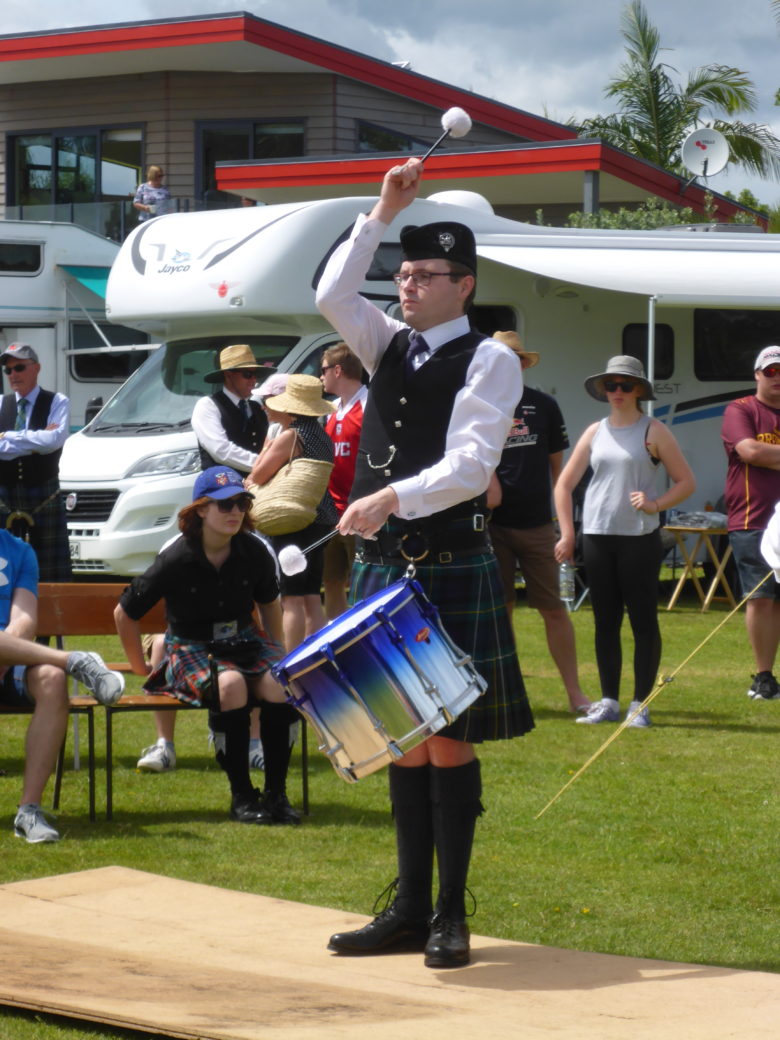The Offshore Highland Games
Between here and Auckland there is a small very neat town called Waipu to which many Scots came back in the early 19th century from their homeland and from North America. Apart from starting successful businesses they maintained their Highland culture and re-established their ties with the clans. In 1871 they held the first New Years Day Highland Games in the heart of their town and we were fortunate enough to visit the 146th Waipu Highland Games.
In the main arena a young lady looking ordinary in shorts and a T- shirt, stood firm as the caber was lifted towards her. She took hold of the wooden trunk when it was near vertical and slowly lowered her hands till they were near the bottom. Then very carefully she lifted the log, staggered forward a few metres and threw it with all her might a short distance forward.
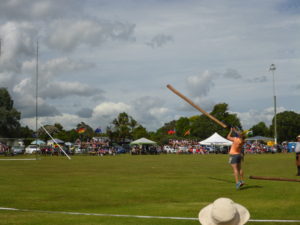
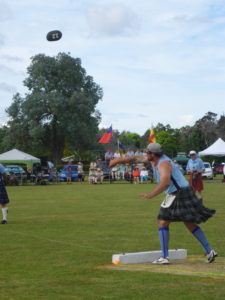
Further around the arena an orange wigged highlander lobbed the wheatsheaf in the shape of a 16lb weight up above his head and behind him to go over a horizontal bar. The weight caught the bar and pinged back from whence it came causing a gasp in the audience just as the man sensibly stepped forward at the same time as the weight thumped into the ground just behind him. Phew.
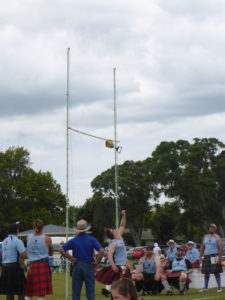
The grassy ‘street’ on one side of the field was bordered with tents flying colourful banners and flags. Inside tartan fabric, kilts and clothes, maps and brochures of Scottish history, smoothies and ice cream, jewellery, food, Gaelic art and decoration were for sale.
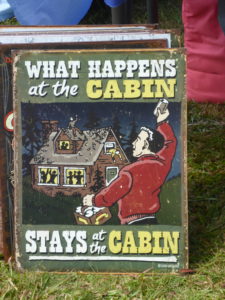
We found Ruth with her husband surrounded by trestle tables laden with books, maps and pictures and ready to help keen visitors trace their family roots. In my case my maternal grandmother was quarter scots and her tartan was the subdued Lindsay design of dark blue and purple, one of the nicest in my view.
As my connection to Scotland was so thin we talked about Ruth instead. She left the small village of Heathrow the year I was born when it was near to the Second World War airfield. At the time we were chatting Charly and Tom were flying back to the UK in a Boeing 747 to land on the 5th runway that was built over Ruth’s childhood home. She dislikes returning as Heathrow has changed so much.
We wandered on down the street towards one of the three covered wooden stages. Children aged from seven to eighteen took part all day long in serious dance competitions. In colourful combinations of full Highland dress they danced the fling in twos and groups to the tune of a single piper and in front of very critical but smiling lady judges. I wondered if this was part of their school curriculum or an extra-curricular activity.
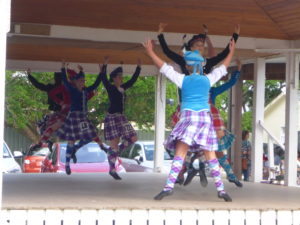
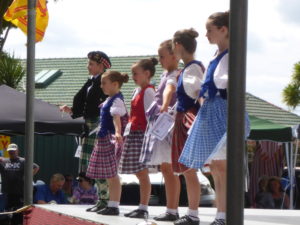
Irish dancers performing the ‘jig’ dressed in mostly green reminded us of The Riverdance and young ‘sailors’ in white tunic and bell bottoms dancing to the hornpipe reminded us of the days of Nelson!
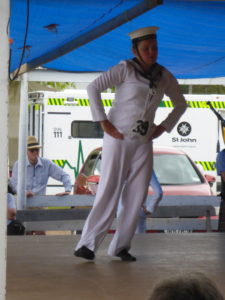
Heads were tilted aloft as a single sky diving, kilted (!) member of the Ballistic Blondes fell from a plane above and landed just infront of us and we were among the few folk listening to pipers of both genders playing their pieces to the judge while walking very slowly around their stage.
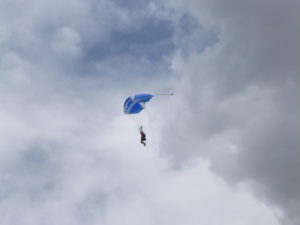
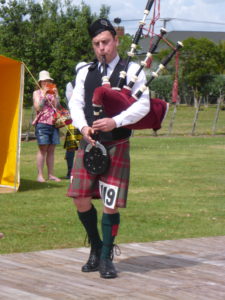
But the best part of all for me was the Tug-o-War. Next to us a young lad was yelling his loudest in support of his team and more people were watching him and smiling than were watching the competitors. Amazingly the little baby he was holding was unperturbed by the racket. It seems that the technique of gaining the best pull at the start only works if it can be held to the last.
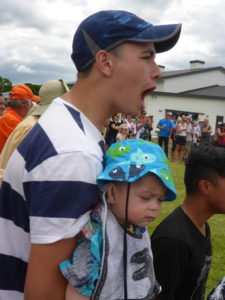
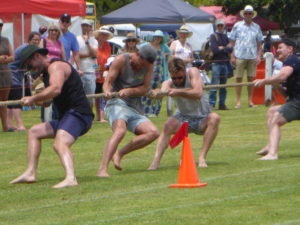
Also might is only useful if it comes with fitness. Some teams were made up of big men but they ran out of energy in no time and one big guy had the man behind him land on him. He had to lie on the sidelines in agony while his team was beaten in the final. But it was all very good fun for the spectators anyway.

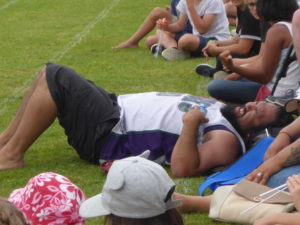
We will visit the Waipu Museum to learn more on our way south.
About Thyme.
You may remember I mentioned in a previous blog the boat next to us called Wild Thyme, whose times were past their best. Lichen and orange algae cover her netting and engulf her halyards and shrouds, but underneath we could see she is a beautiful old lady awaiting kind, skilled hands.
Her owner, thin, wiry and pony-tailed John, arrived the other day and we started chatting. Built in Christchurch around the time I was born and Ruth was making her way out here Wild Thyme was being built. She has a sound wooden hull sheathed in fibre glass and it is only the flaking paint layer that needs attention.
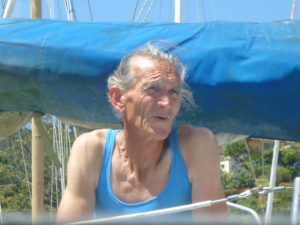
John arrived in Whangarei with his wife Beryl and four boys, the youngest of which was just learning the art of walking, and deciding they liked the place decided to stay awhile.
They cruised around the Pacific for a number of years. “She likes a good wind to get going but when she does she’s very fast and her 6 ton keel gives her good stability, but boy she’s wet.” Her gunwales were a good eighteen inches lower than ours. His eyes wandered affectionately along her hull. “We were rounding the North Cape a while back and the most awful weather met us, the boat behind was rolled and they didn’t make it.” He stood on the foredeck and pushed the wood. “See, here its soft so I think I was sold a duff load of ply and now the decks need replacing again, but it won’t take me long to fix her up.” For sail or sale we wondered.
John was awaiting a tow from Norsand Boatyard so he started cleaning her up as part of the refit while he waited. Although his engine only has 400 hours on the clock, unlike our 1300hrs, his steering system was seized so he couldn’t move her himself. We could tell she was quality built down below because the wooden drawers he brought up on deck to dry after he had washed them were well made with mitred joints.
We heard the sounds of a conversation and saw that John’s tow had arrived. An inflatable dinghy about the same size as ours with no fixing for a tow line and one man who was busy undoing WT’s lines. Is he for REAL we wondered? Very slowly he moved her forward from her four piles while steering the outboard motor at the same time.
The dinghy slithered from side to side while WT, with the reluctance of donkey up a tailgate, followed until she reached the Marina Office and then like a donkey that’s changed its mind she turned herself through a full circle and headed for home.
Poor John, we felt sorry for him. “They’ve given me dates and cancelled them that many times,” he said, “And now they can’t come again till the end of January.” He rowed ashore for a night’s sleep in his car. He didn’t sleep on board because his car has been broken in to four times in the car park, so he kept guard.
The next morning we offered him an alongside tow with Zoonie but he declined, “That’s awesome and thank you but I don’t want to be left moored off the boatyard awaiting their convenience. Rather she was safe here while I’m back home.”
He’s a fisherman and builder by trade and no doubt when he does finally get her lifted and under cover she will respond to his skilled hands in no time. I just hope we get to see her.
Pfaffs Away Chaps.
It is a known fact that making dinghy chaps can be the cause of marital strife in otherwise happy couples. We pondered this fact as we sat in The Butter Factory, pint beer glass in hands watching the Sailrite (they make sewing machines for sailors) video on how to do just that. If nothing else we could use her ideas if they suited us and if they went wrong blame the lady in the video.
The chaps are needed to protect and prolong the life of the dinghy against wear and tear and more especially in the Tropics, the SUN. They are made to fit on the dinghy while it is in use so are more complicated than a cover-all. We had been quoted between $700 and $1200 to have them made. No way hosey, not with our lovely second-hand Pfaff sewing machine on board.
So off we marched hand in hand as usual, one other free arm holding the sunbrella offcuts and the other the plastic for the pattern. In fact we did follow the lady’s guidance quite closely and it was very useful. Another important factor as the measuring, hot knife cutting and machining was quite tiring and knowing when to stop. Beyond that point not only do tempers become frayed and mistakes made but the whole task becomes a chore. So we’d start early when it was cool for working on the dinghy on the foredeck and finish for the day around late lunchtime and then do something quite different.
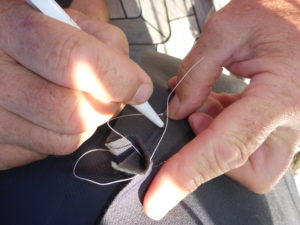
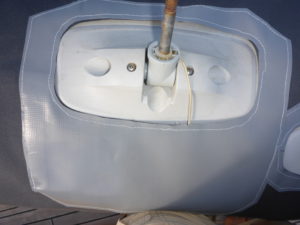
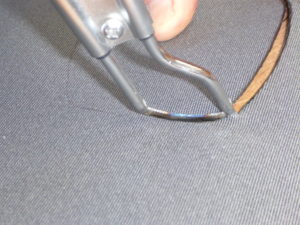
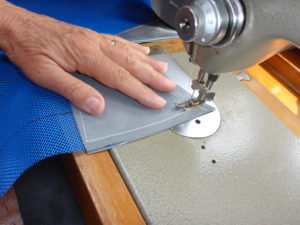
So it was that on day five all that was left to do was hem the inner seam with Velcro strips in place, mark on the dinghy where the Velcro on vinyl strips needed to be stuck opposite the sewn ones and pull the outside pull cord tight at the back and bingo we were done. Chaps all done, chaps.
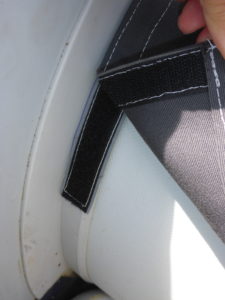

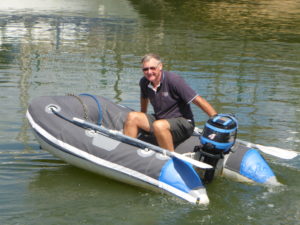
An immediate celebration was called for, so off we went to the Killer Prawn Restaurant with its global reputation, to have a late lunch. This is an understated place (‘scuse the pun). We had picked up a brochure and were tempted but they do not feel the need to advertise on local radio as the quality of their food does that for them.
The big restaurant has a lovely atmosphere, built of wood and warm red brick with friendly staff. On one wall are framed magazine articles because the chef likes to publish his new recipes so others can enjoy making them. Rob had shell on prawns in curry sauce with salad, sweet chilli and rice and I had my prawns cooked in garlic and white wine. So delicious I must make a note to pad ‘family venue’.
Whangarei Old Geysers, a weekend swap and Camping preps.
I wrote the last blog on Friday 13th January. I didn’t realise the date until the computer ate and swallowed the blog, never to be seen again. It has happened before when I wrote the blog as an email ready to send and it was lost forever from the send box. So I thought I’ll be doubly sure not to lose it by writing it in Word where a copy will be saved even if Mailasail does lose it again.
So this time it was lost as I transferred it to Mailasail. Gone from Word and Directory even though I had saved it. I got over the frustration that caused the air on Zoonie to be mid Atlantic blue for a while but my problem was remembering what I had written. It came back over the morning and fortunately Rob had read the blog so could help me recall passages.
So now I will save it on the external hard drive before moving it anywhere on this suspicious, sometimes malevolent little computer of ours.
Today there is very little wind here in the basin and I hope it is the same elsewhere. Yesterday the South Island and south of the North Island were hammered with strong winds and heavy rain (400mm in one hour in places) coming from an intense low off the Tasman Sea and I’m glad we weren’t pitching our tent at the time.
On the Quayside of the river opposite us there are a number of typically very old, wood built motor launches in pristine condition and lavishly painted in white paint. On one lives one of the ‘single’ Old Geysers of Whangarei Marina. There are a few who live alone but have plenty of company around them a pontoon or pile away.
This particular gentleman paddles around in his red plastic canoe for exercise and to socialise and we have chatted on occasion. On the spacious afterdeck he has his hammock, barbecue, director’s chair, and his hose. Apart from filling his water tank with it he waters his potted herb plants, washes around the un-used anchor and bow each day and, if the day has been on the hot side, he aims the hose down the front of his shorts for a few delicious moments and then down the back, just to maintain balance you understand.
Vince is on the opposite side of the river and we pass him each time we leave the dinghy to go ashore. He is married but his wife is now in a wheelchair so he comes to the boat most days to potter, polish the already shiny stainless, clean the already brilliant white paintwork. He is a sweet, friendly man, the sort you’d be lucky to have as a grandpa.
Two other guys live aboard their homely boats and spend much of the day sitting at the bench that looks over the river by the shower block. Charlie is very large and the other of medium build, the latter always has a chat line ready and they both wave as if we were long lost friends as we motor back to Zoonie.
Just to balance things I have to tell of two less friendly guys. ‘The Admiral’ has his boat moored on a finger at the outer end of the pontoon behind us. He wears an ‘officers’ cap, has a short white beard and walks around with an air of having known a much prouder, distinguished past. He also secures a rope from his stern across to the stern of his neighbour, to ensure the likes of us do not tie up our dinghy in the gap between the boats to go ashore or as would be the case in the dark, get rope burns around our necks.
Then there’s Bert (that’s obviously not his real name, his real name is Frank, no its not that either) who is a cruising yachtsman who sails a very nice yacht with his long suffering wife. He is the hygiene mafia all rolled into one. Ticking people off for putting the wrong rubbish in the wrong bin. He did this to Kyle and Shelley, suddenly appearing on their boat, head poked down the companionway, bee in his bonnet. He got the wrong people of course, and left the boat briskly, with a sizeable flea in his ear and a few more words in his vocab.
Yesterday we were in the shower block while I was ironing when there was a brusque ‘ratatat’ on the door. Someone had forgotten their key. Rob opened the door for him and Brank or Frert, which do you prefer (?), looked at Rob, pushed his way in and started chatting to someone across the room. “Gauche twit” I said in a not too hushed voice. We got to know him later and that’s it really, he is fine once he knows you.
I was ironing a dress I have made for Ruby’s 6th Birthday present. Our granddaughter and her family and friend Lauren are coming to visit us in April and Ruby will be spending her entire birthday up in the air, so of course we will celebrate when she arrives. Having the second-hand sewing machine at my disposal I decided to make her a birthday present.
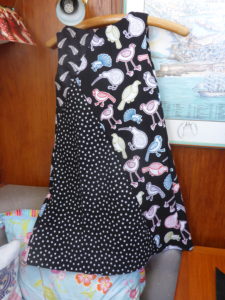
I wanted to get it finished before we went camping and not rush the job on our return before her arrival. I also had other machining jobs to finish. We now have a new Hydrovane sail cover in place, the old one was so weathered by UV and salt air that it would split if you so much as looked at it. Also the corners on the shroud awning covers, where the eyes and guys are attached were torn so I folded squares of the grey sunbrella scraps and machined them over the corners. Rob then had eyelets attached and we are ready for next season in the tropics.
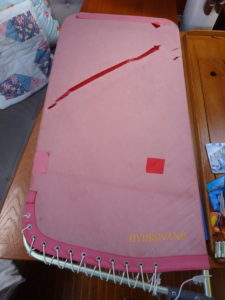
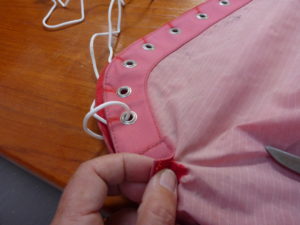
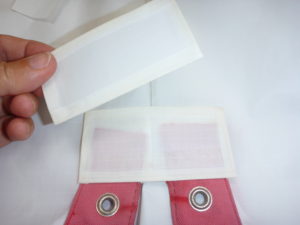
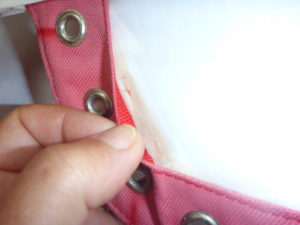
The weather forecast for last weekend was fine on Saturday and rain on Sunday. So we swapped the days and took Saturday off. Rob suggested we visit Abbey Caves and check out the glow worms.
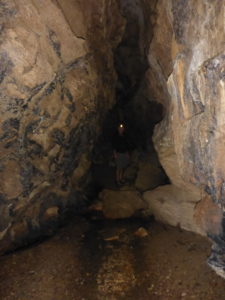
In 1860 Nathaniel and Amelia Clodworthy (love that name) settled on 409 acres of mixed grass and woodland and raised a family. Their descendants were still living in the area until 2009, although not in the wooden house located amongst limestone outcrops Nat and Amelia build, shaped like an Irish Abbey, which burned down in 1920.
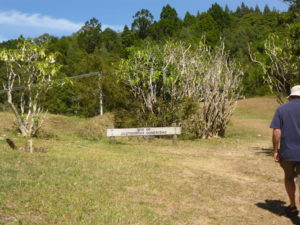

There are gentle pastures and deep gulleys all over their land and at least three undeveloped caves, Organ, Middle and Ivy and we scrambled down into all three. From bright sunshine and warming air to the cool of the rock walls and the pure water running along the flat floor, around the bend and into pitch dark. With our torches turned off we looked up and saw pin prick constellations of bright greenish light, the little worms were aglowing.
I spoke with a lady from Glasgow, on holiday for five weeks who let her husband and friends venture into the depths of Middle Cave and a young lady appeared in floral wellies, loaned to her by her landlady. They weren’t ideal as they slipped on the rocks.
Making our way back up the hill to the road the path led right through the site where the Clodworthy’s house had stood for sixty years. The Datura trees, now at the end of their flowering season, once beautified the outside of their home and just down the hill the family plot was protected by a mesh fence and the shade of native bush and hardwood trees. A fire destroyed their home leaving only the stone fireplace as evidence it had ever existed.
One rich experience on a fine day inspires another so, back on board, we pumped up the canoe and paddled up the river curious to see how far we could get.
Around a couple of bends the river moves away from the road and birdsong replaces traffic noise. Heavily forested slops rise up to Mount Parihaka with its fab views over the city we had enjoyed with Gail and Tony. The riverbed was clearly visible beneath us and we were keeping an eye on the closeness of the rocks. “At least they are worn smooth and not sharp Rob” I said as the canoe rose up and slithered over one. Staying in the darker water we made it a little further, to the pretty picnic area where we had previously munched Gail’s lovely buns and drank red wine while mother ducks kept their broods in order.
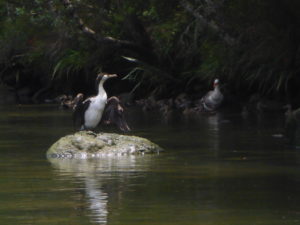
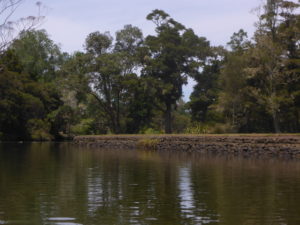
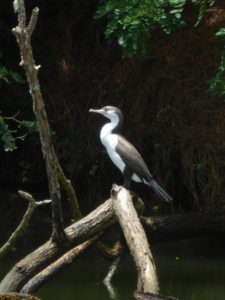
On the paddle back down river the bleached dead branches of an old tree supported snoozing shags and a two man band played over our heads as we floated beneath the artisan bridge.
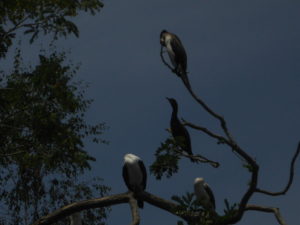
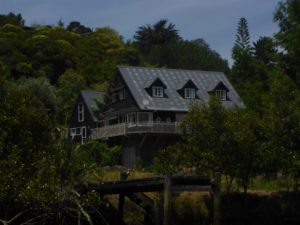
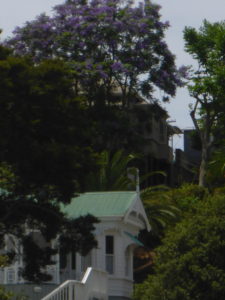

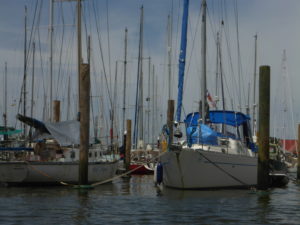
The next day, Sunday, we stuck to our plans and spent the morning working. Rob replaced the engine oil in the gearbox with gear box oil. The engineer who did our major engine service either slipped up or was cutting corners or he knew something we didn’t. He was right, in these warmer climbs we can use engine oil in the gearbox.
Rain stopped our plans to do the Hatea Loop Walk, so early the next morning we set out instead. I mention this only because that time of day was good for our bird count. Three kingfishers in the same area and a new bird with long red legs and a white face, the pied stilt.
When on board we often tune in to the local radio station. It is funded largely by advertisers, “Lawnmower a pain in the grass, come to so and so for repairs”. That was my favourite. The NZ sense of humour can be found on the roads as well, “Last cheese for miles” short and sweet.
Just for a change Rob had a browse around the frequencies the other day and found that we could re-tune our boat radio to Australasia instead of International that it had been on since the UK. On 104.4khtz Radio New Zealand (RNZ) transmits really interesting programmes and music on subjects such as the up and coming Haka competition near Hastings (Haka is the Maori welcome ceremony we watched at the Waitangi Treaty Ground).
We also listened to an interview with an American environmental expert talking about rebuilding the world’s kelp forests, such as we saw around The Poor Knights Islands. Coral that has been deprived of the rich nutrients it absorbs from kelp becomes pale and unhealthy. Replace the kelp and it has been seen to regain its colour in 24 hours. Also fish thrive under the kelp which attracts bigger fish so the feed chain can function and diversity of life is maintained.
I worried when we first came here that Maori culture was lost as a way of life and survived only as history re-enacted for tourism. Well the performing arts have absorbed and therefore preserve the culture of indigenous populations all over the world and apart from radio they now have their own TV station, which is global. I’d love to find a way into that. Where are you Mr Google?
Plans for our NZ Odyssey are well advanced. We have six tent stops between here and Wellington (For the ferry). Scott who at this moment is fitting our new Auto Pilot, is from the South Island and in the space of a few minutes he has told us the best places to visit down there. So apart from packing and buying some food items we are nearly ready and hope to set off next Monday 23rd January. I cannot wait to see the differences and similarities between the two Islands.
